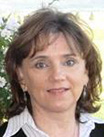
Linda Espinosa, Ph.D.
Lead Consultant, Best practices for young dual language learners at California State Dept of Education;
Co-PI at Center for Early Care and Educational Research-Dual Language Learners, FPG, U of North Carolina-Chape;
Professor, Consultant, Author at University of Missouri
Linda Espinosa is a Professor Emeritus of Early Childhood Education at the University of Missouri, Columbia. She has served as the Co-Director of the National Institute for Early Education Research (NIEER) at Rutgers University and Vice President of Education at Bright Horizons Family Solutions. Her recent research and policy work has focused on effective curriculum and assessment practices for young children from low-income families who are dual language learners. She currently is the Co-Chair of the First Five, Los Angeles County Universal Preschool Research Advisory Committee and was a member of the National Task Force on Early Childhood Education for Hispanics Technical Advisory Group.
Dr. Espinosa also served on the Head Start National Reporting System (NRS) Technical Advisory Group and has just been sworn in as a member of the Secretary's Advisory Committee on Head Start Research and Evaluation. She has published more than 70 research articles, book chapters and training manuals on how to establish effective educational services for low-income, minority families and children who are acquiring English as a second language. Dr. Espinosa has worked extensively with low-income Hispanic/Latino children and families throughout the state of California as a school administrator and program director in San Francisco, San Jose, and Redwood City. Her latest book is Getting it RIGHT for Young Children from Diverse Backgrounds: Applying Research to Improve Practice (2010).
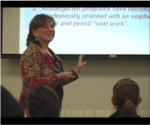 |
1. Introduction
"Kindergarten teachers have faced great challenges in juggling all of the elements of a developmentally appropriate program for a very wide range of ages and backgrounds. Kindergarten children can be functioning from the two and a half year level to the seven year level. People understood that we need to do something and that Transitional Kindergarten may be a response to it. " |
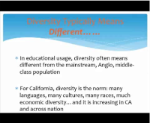 |
2. Definitions of Diversity
"Diversity typically means different. In educational usage it typically means different from mainstream, Anglo, middle-class population. For California, diversity is the norm and it is increasing across the nation. This population is historically underserved and inappropriately served. Growing diversity means growing challenges and opportunities." |
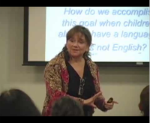 |
3. Socioeconomic Status and Educational Achievement
"The fact that a child speaks another language at the home is not a risk factor necessarily, yet people still view this as a disadvantage. Spanish speaking children who come from a high socioeconomic background achieve in comparable ways to monolingual English speakers. There is a huge confound between socioeconomic status and language in this country." |
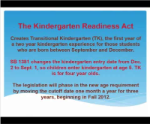 |
"The Kindergarten Readiness Act creates Transitional Kindergarten (TK), the first year of a two year kindergarten experience for those students who are born between September and December. Children enter kindergarten at age 5, while Transitional Kindergarten is for 4 year olds." |
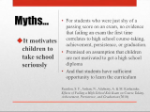 |
5. Traditional versus Transitional Kindergarten
"Transitional kindergarten is the bridge between preschool patchwork and traditional kindergarten. Transitional kindergarten has an emphasis on language and communication, the social and emotional, and academic decoding. Transitional kindergarten offers an enriched, high quality program for children who will greatly benefit and can provide one solution to the growing problem of Kindergarten readiness." |
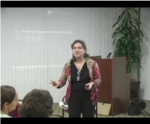 |
6. Science Research and Dual Language Learners
"The research base for dual language in early education is just beginning to grow. How can science research guide our policies and practices for dual language learners and how persuasive is the research base?" |
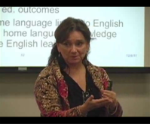 |
7. Closing: Neuroscience and Language Learning Capabilities "The neuroscience contribution to language learning in early childhood is going to help us move away from limitations of viewing these children from the negative lens of learning language as an adult. Our obligation is to capitalize on this language learning capacity while honoring the principles of home language maintenance." |